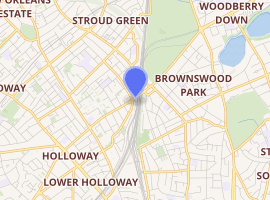The Sir George Robey
The Sir George Robey was a mid-19th century public house and later a music venue on Seven Sisters Road, Finsbury Park, North London, England.[1][2] Formerly called The Clarence Tavern, it was renamed in honour of the music hall performer Sir George Robey (1869–1954) in 1968.[1][3][4]
.jpg)
| Sir George Robey | |
|---|---|
.jpg) The pub standing derelict and roofless, in July 2008 | |

| |
| Former names | The Clarence Tavern |
| Alternative names |
|
| General information | |
| Type | Public house |
| Address | 240, Seven Sisters Road |
| Town or city | London |
| Country | United Kingdom |
| Coordinates | 51.5631472°N 0.1072636°W |
| Opened | mid-19th century |
| Demolished | 2015 |
| Designations | Locally listed |
The pub was a Meux's house, and was noted for a plaque advertising their Original London Stout, which remained on the building until its demise,[1] long after the brewery's closure in 1921.[5]
During its time as a music venue, artists who performed at the Sir George Robey include Bad Manners, Billy Bragg, Carter USM, Desmond Dekker, Fairport Convention, Gong, Hawkwind, Bert Jansch, Roy Harper, Ralph McTell, and They Might Be Giants.[1][2][4][6] Blur's Damon Albarn recalled:[7]
That was right at the start of Blur. Graham [Coxon] and Alex [James] were still at Goldsmiths so we were just doing our first gigs. First on the bill at an indie all-dayer at the George Robey pub in Finsbury Park which meant we were on at eleven in the morning and just got pissed for the rest of the day, taking advantage of the beer coupons.
Live albums recorded at the venue include Steve Marriott's Packet of Three's "Live at the Sir George Robey 23-10-85".[8] The pub also hosted punk and ska all-nighters, and 'Club Dog' acid-house nights.[9]
After being renamed The Powerhaus in March 1996, when it was taken over by the Mean Fiddler Music Group,[1][2] and later named Robey,[10] it closed in 2004.[1][8][11]
Despite being locally listed,[12] the building was demolished in 2015,[13] after a period standing derelict, during which it was occupied by squatters[6] and had its interior fittings and floors removed.[8][10] As of April 2018, the site is still vacant.[14]
The pub was directly opposite another, larger, music venue, the Rainbow Theatre.[8]
The fictitious venue The Harry Lauder in Nick Hornby's book Fever Pitch was based on The Sir George Robey.[4] Near the end of Irvine Welsh's novel Trainspotting the characters Sick Boy and Begbie visit The Sir George Robey.[15]
References
- "The history of London's 10 greatest live music venues". History Extra. BBC History Magazine. Retrieved 4 May 2018.
- O'Connor, Joe (3 July 1999). "Jigging in the park". the Guardian. Retrieved 4 May 2018.
- Dictionary of Pub Names. Wordsworth Editions. 2006. ISBN 978-1-84022-266-1.
- Talling, Paul (2008). Derelict London. Random House. p. 88. ISBN 978-1-905211-43-2.
- Lesley Richmond; Alison Turton (1990). The Brewing Industry: A Guide to Historical Records. Manchester University Press. p. 233. ISBN 978-0-7190-3032-1.
- Dean, Jon. "Squatters evicted from famous Finsbury Park pub". Islington Gazette. Retrieved 4 May 2018.
- Mash, Julian. "Book Extract – Under The Westway with Damon Albarn". Q Magazine. Retrieved 4 May 2018.
- Allen, Carl (2016-04-15). London Gig Venues. Amberley Publishing Limited. ISBN 978-1-4456-5820-9.
- "A Cosmic Dog". Record Collector. No. 448. Christmas 2015. pp. 54–60.
- "Robey, Finsbury Park". What Pub?. CAMRA. Retrieved 4 May 2018.
- Other sources give dates from 1996-2002
- "Finsbury Park Town Centre Supplementary Planning Document Draft for consultation" (PDF). Haringey Council. April 2013. 3.5.14. Retrieved 4 May 2018.
- "Derelict London - London's Lost Music Venues". Derelict London - Photography, Social History and Guided Walking Tours. Retrieved 1 May 2018.
- "Build flats on George Robey pub site". Camden New Journal. Retrieved 4 May 2018.
- Steven, William (2017-10-28). Scottish Storytrails: A Literary Landscape. Neil Wilson Publishing Ltd. ISBN 978-1-906000-85-1.
External links
- Crowd-sourced concert set-lists at setlist.fm